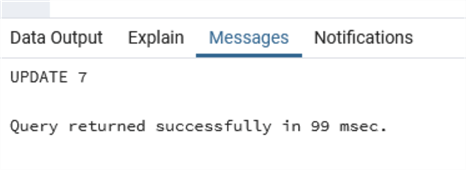
Postgres=# delete from t1 using t2 where t1.id=t2. Postgres=# insert into t1 values (2,'t1') Postgres=# insert into t1 values (1,'t1') Postgres=# create table t2 (id int, info text) Postgres=# create table t1 (id int, info text) Postgres=# delete from t1 using t2 where t1.id=t2.id
#Postgresql update update#
Postgres=# update t1 set info=t2.info from t2 where t1.id=t2.id Postgres=# insert into t2 values (1,'t4') Postgres=# insert into t2 values (1,'t3') Postgres=# insert into t2 values (1,'t2') To update between compatible versions, you simply replace the executables while the server is down and restart the server. Postgres=# insert into t1 select generate_series(1,10), 't1' Postgres=# create table t2(id int, info text) postgres=# create table t1 (id int primary key, info text) In a scenario where a Cartesian or one-to-many or many-to-many JOIN operations occur, the database might not know the target row for which the value needs to be updated. (0 rows) Batch Update or Deletion -If Cartesian or One-to-Many or Many-to-Many JOIN Operations Occur

If you want to clear the table, we recommend usig truncate. Then, the easiest way to perform the update is to insert the data into a new table and rename it afterwards. If you can safely drop the existing table and if there is enough disk space.

Use other table names after 'using' to perform multi-table JOIN batch deletion. The fastest way to update a large table is to create a new one. test03=# delete from test using (values (3),(4),(5)) as tmp(id) where test.id=tmp.id Use other table names after 'from' to perform multi-table JOIN batch update. UPDATE HUMAN SET ADDRESS 'Miami' WHERE LICENSENO 44 Here is the result after the updation. Let’s understand its query and then its implementation.
#Postgresql update License number#
test03=# update test set info=tmp.info from (values (1,'new1'),(2,'new2'),(6,'new6')) as tmp (id,info) where test.id=tmp.id The following is an example, which would update ADDRESS for the customer name, whose license number is 44. The corresponding copy interface varies with the language driver. +-+-Įnter data to be copied followed by a newline.Įnd with a backslash and a period on a line by itself. Unlike Insert protocol, the Copy protocol is more streamlined and makes insertion more efficient. Let’s take a look at an example to understand how the PostgreSQL UPDATE join works. Postgres=# insert into tbl1 (id,info,crt_time) values (3,'test3',now()) Postgres=# insert into tbl1 (id,info,crt_time) values (2,'test2',now()) sudo apt update & sudo apt -y full-upgrade. First, create the sequence using the below command. Login to your Ubuntu server and run the following commands to update all the packages installed. Postgres=# insert into tbl1 (id,info,crt_time) values (1,'test',now()) In Postgresql, we can use auto-increment with sequence to provide unique value to each record in the table. Strictly speaking, this is not a batch operation, but it helps to reduce the synchronization wait time when transactions are submitted. Use the values(),().() method as shown below. postgres=# insert into tbl1 (id, info ,crt_time) select generate_series(1,10000),'test',now() How do I delete multiple records at once?īatch operations help reduce the interactions between databases and applications and improve data processing throughput.How do I update multiple records at once?.How do I insert multiple records at once?.LEFT JOIN produce AS p ON s.produce_id = p.This article aims to answer all the following questions: The price field in the Produce table is updated from the shipment’s produce_price field as shown here: UPDATE produce Use the UPDATE and JOIN Statements to Update the Table in PostgreSQL Here’s the INSERT statement to populate the Shipment table with test data: INSERT INTO shipment (produce_id, produce_price) Shipment table: |id | produce_id | produce_price|ĬONSTRAINT fk_shipment_produce FOREIGN KEY (produce_id) REFERENCES produce (id) Here’s the INSERT statement to populate the Produce table with a default cost of 0: INSERT INTO produce(price) In this example, there are two tables: Produce and Shipment. The product’s price is updated to reflect the current market price whenever a shipment arrives. Produce Shipment Example in PostgreSQLĬonsider a store that sells food produce. Otherwise, all the rows would be updated.

You can use WHERE clause with UPDATE query to update the selected rows. The PostgreSQL UPDATE Query is used to modify the existing records in a table. This tutorial will walk you through updating a table using UPDATE and JOIN statements. Google BigQuery & PostgreSQL : Big Query for Data Analysis.


 0 kommentar(er)
0 kommentar(er)
